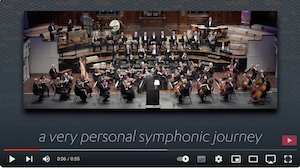

Symphony No.6
by Anthony Ritchie, for orchestra, Opus 212
Symphony No.6 was begun during the first lockdown in New Zealand Autumn 2020, and to some extent informed by the crisis enveloping the country and the world. However, the work is also inspired by personal experiences, beginning in 2019 and book-ended by the composer's serious illness in 2021. It expresses ideas around love, death, and our relationship to the environment.


A Rattle Records CD of Symphony No. 6 has been recorded by the New Zealand Symphony Orchestra and is now available for purchase.
The cover art is by the talented Joselle Bontilao.
Symphony 6 has been reviewed by Nick Barnard of MusicWeb International and Elizabeth Kerr of Five Lines
- Year: 2021
- Duration: 33 minutes
- Instrumentation:
Piccolo, 2 flutes, 2 oboes, Cor Anglais, 2 clarinets, Bass clarinet, alto saxophone, 2 bassoons
4 horns, 3 trumpets, 3 trombones, 1 tuba
Timpani, 3 percussion: cymbals, tam tam, tubular bells, glockenspiel, xylophone, vibraphone, marimba, bass drum, triangle, crotales, Harp,
Strings
Programme Note
Although the four movements have sub-titles this is not a specifically programmatic symphony: the listener can use these titles to develop their own thoughts and ideas as the music unfolds.
Musically, the symphony is unified by a recurring love theme on the saxophone that opens the work. The love theme is developed in the first movement and reappears in the second movement on trombone; in the third movement, it is hinted at by bird calls at the start (on flutes and piccolo) before the saxophone returns at the end of the movement; the love theme also recurs in the coda of the fourth movement, on strings and tuned percussion.
The tonality of E flat minor also acts as a type of unifier and symbolises death. The specific chord E flat-G flat-A flat-B flat returns in certain important parts of the structure - at the opening of the fourth movement, for example.
I - Crisis - 12:30
Following a gentle opening, the first movement develops strongly rhythmic themes and motifs, driven by strong pulse. There is a sense of turmoil in this movement that is left unresolved at the end.
II - Meditation - 6:30
The second movement features a haunting melody on cor anglais, answered by solo strings.
Here, the music constantly vacillates between contrasting tonal centres, before building to a more lyrical middle section. The recapitulation of the main theme is highly
decorated and colourful.
III - Spirits - 6:30
The third movement is elusive and free in character, with bird calls on flutes and piccolo underpinned by harp, celesta and tuned percussion. This contrasts with a broad, emotional theme on strings that is more human in character. Following a climax at the end
the solo saxophone returns with its love theme, leading directly into the finale.
IV - Grieving - 7:00
The finale opens with a strong statement of the 'death' chord, E flat minor, and develops melodic lines that
connect back to earlier themes. The coda is lyrical, underpinned by gently harp ostinatos, bringing the symphony to an end with an emotional 'farewell'.
The symphony's first live performance was on September 23, 2023 by The Dunedin Symphony Orchestra under Simon Over.
Dedicated to Sandy